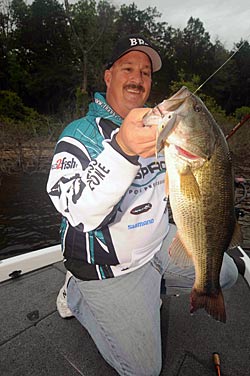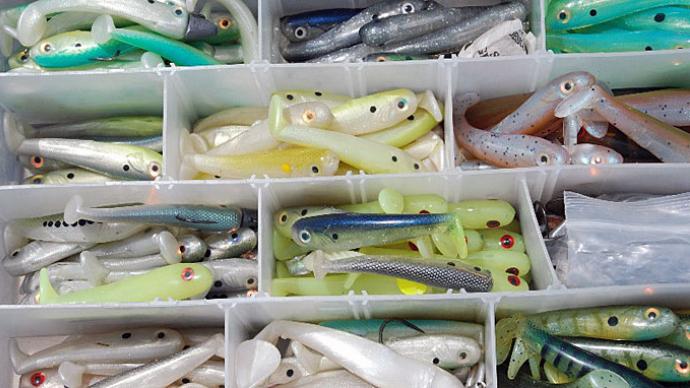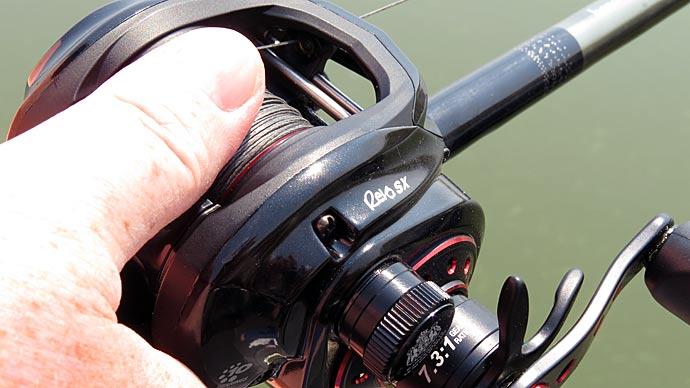
Soft plastic swimbaits have become a hit for many bass anglers, but the hard plastic jointed versions have never achieved as much notoriety.
An accomplished bass angler relies on soft and hard plastic swimbaits to trick bass in California pro Bill Siemantel. The Spro lure designer notes that each type of swimbait has a different action and hook placement, allowing anglers to use each for various applications.
The soft plastic swimbait, with its boot-shaped tail and hook on the top of the lure, generates its action from the rear and reverberates to the front. With its weight located in the front of the lure, the soft swimbait falls head first, making it ideal for fishing vertically.
The action of a hard plastic jointed swimbait originates in the front of the lure and moves towards the back, so it swims more horizontally through the water column. “So you can have a top, middle, and bottom countdown system (with the hard swimbait), and when you rip it and jerk it, it articulates left and right, and you get a more horizontal movement forward than the boot-tail swimbait,” Siemantel says. When fishing the lure higher in the water column, your catch rate increases with the hard plastic swimbait because the hooks are on the bottom, and bass usually attack the lure from underneath.
Siemantel uses the lure’s versatility to fish it in several ways. When fishing from the bank out to 6 feet deep, he slow rolls or twitches the Spro BBZ1 slow sinking model. Once the lure arrives at a tree or other cover, Siemantel lets it fall like a Senko next to the target. He also likes to use the lure as a rip bait to make it constantly change directions. The slow-sinking model can also be used like a suspending stickbait by pausing it next to the suspended bass and letting it fall slowly.
The fishery, forage, and water color determine Siemantel’s hard plastic swimbait size and color choices. He notes the 6-inch lavender shad swimbait has produced largemouth, smallmouth, and spotted bass everywhere he has fished. Siemantel believes the 6-inch lavender shad slow-sinking BBZ1 is the most versatile bait. “I can drop it down in the water column down to 10 feet, and then I can still reel it a little bit faster and use it as a wake bait,” he says. The 4-inch BBZ1 is Siemantel’s choice for fishing waters containing smaller baitfish such as threadfin shad; the 8-inch model is his pick for fisheries noted for producing trophy bass.
From late fall to the prespawn in early spring, Siemantel likes to fish the BBZ1 on structure. “I am looking for points, humps, creek channel bends and flats—places where bass are either going to stage going into spawning areas, or they are setting up to eat baitfish before the spawn,” Siemantel says.

The tournament veteran scans the structure with his electronics to find baitfish and then presents his swimbait to bass hanging around the forage. “The beauty of the 6-inch Spro BBZ1 fast-sink model is if you see fish in 10 to 20 feet of water, you can let it drop down and fish different water columns.”
Siemantel describes his retrieve as “old school” (just reeling it steady) for wintertime bass. The key to the retrieve is to imitate the action of the baitfish. If the baitfish appear sluggish, Siemantel will slow roll the swimbait. He works the swimbait with a 7-foot, 4-inch Daiwa 741 medium-fast rod and Daiwa Lexa 300 (8.0:1 gear ratio) baitcast reel filled with 18-pound Maxima ultra-green monofilament line.
The lure innovator also attaches his hard swimbaits to an Alabama rig to catch wintertime and prespawn staging bass. He attaches 4-inch BBZ1 swimbaits on the outside wires of the rig and then attaches a 6-inch model on the back wire, so his rig looks like a chase scene of a bigger fish pursuing the smaller bait. He favors using an umbrella rig with thin wire, which makes the lures pulse more and compresses better when he twitches the rig to create the flaring action of a bait ball.
The same steady cadence or slow roll Siemantel employs with his single hard swimbait also works for his Alabama rig. “The A rig is a miniature funnel (resembling baitfish merging into a ball and causing bass to attack it),” Siemantel says. “Bass, realize this is the best opportunity to go through and get as many baits on one swipe.”
The BBZ1 produces for Siemantel in the late winter, even when fishing is tough on the clear California lakes. “I have had 15 to 30 fish days on our lakes then,” Siemantel says. He and his partner won back-to-back team tournaments on Lake Castaic using the 6-inch slow-sink BBZ1 with weights of 20 1/2 pounds and 21 1/2 pounds, while the second-place finishers in both events only had about 13 pounds.




